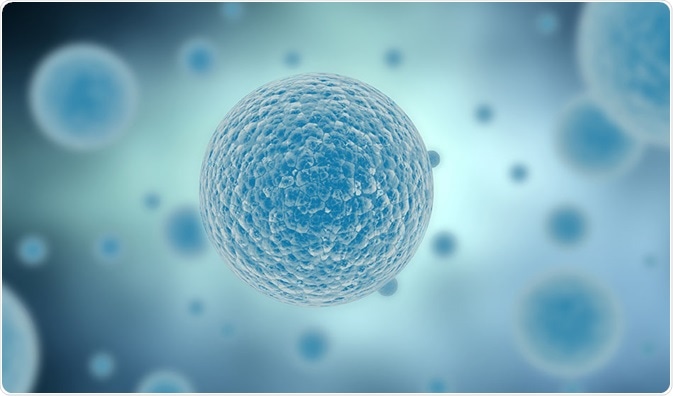G protein-coupled receptors (GPCRs) are seven-transmembrane (7TM) receptors that represent the largest family of membrane proteins present in eukaryotes.

Image Credit: Jezper/Shutterstock.com
GPCRs comprise a single polypeptide that is folded into a spherical shape and retained in the plasma membrane. They are activated through extracellular signals in the form of mediators or ligands. Such signals inform cells about the life-sustaining nutrients present or absent in the cell environment.
This external signal can cause conformational changes in GPCR, which in turn activates a G-protein. When the stimulation is removed, inactivation of G-protein occurs through specific proteins called RGS (Regulator of G protein signaling) proteins.
Ligand binding
Some GPCRs play the role of stimuli and are known as orphan receptors because their ligands have not yet been identified. Other types of GPCRs are bound to the membrane externally, where ligands of GPCR bind within the transmembrane domain.
Protease-activated receptors are activated by cleaving a part of the extracellular domain. Ligand binding disturbs the ionic arrangement between TM-3 and amino residues of TM-6. This causes the GPCR to reassemble and stimulate effector G alpha proteins.
Conformational changes
Depending on whether the protein is in the active or inactive state, a specific G protein binds the receptor. After the ligand is identified, the GPCR undergoes a conformational change that activates and causes dissociation of the G alpha protein from the receptor.
The receptor is then able to activate another G protein or stay in its inactive state. The receptor molecule is in stable conformation between the active and inactive states of G protein. This stability can shift the receptor to the active state through the binding of ligands.
Three types of ligands exist agonists that change the stability for active states; inverse agonists that change the stability for the inactive state; and neutral antagonists that do not cause any change in stability.
The GPCR performs like a molecular switch that is turned on when bound to guanosine triphosphate (GTP) and turned off when bound with guanosine diphosphate (GDP).
Role of G protein subunits
G proteins correspond to the largest enzyme group called GTPases. GTPases are composed of hydrolase enzymes that are involved in the binding and hydrolysis of guanosine triphosphate (GTP). The activated G proteins of the receptor bind to the inner surface of the cell membrane.
The G proteins consist of Gα and Gβγ subunits. The Gα subunit has many classes such as G stimulatory (Gsα), G inhibitory (Giα), G other (Goα), Gq/11α, and G12/13α. Despite performing distinct roles in the cell, each G protein follows a similar process of activation.
In the presence of cyclic adenosine monophosphate (cAMP), produced from ATP, Gsα stimulates a protein phosphorylation pathway. cAMP functions as a second messenger that initiates a pathway leading to the activation or deactivation of PKA (protein kinase A). PKA then undergoes phosphorylation with downstream targets of a myriad of molecules found within organs such as the arteriolar kidney, muscle, and brain.
Giα suppresses cAMP production from ATP. Gq/11α activates a membrane-bound enzyme known as phospholipase C-β, which splits PIP2 (phosphatidylinositol bisphosphate), into IP3 (inositol trisphosphate) and DAG (diacylglycerol).
G12/13α functions in GTPase signaling pathway of Rho (Ras homologous) family and also in the regulation of cell cytoskeleton and cell migration. Gβγ performs some active functions such as coupling and activation of GPCR, determining the potassium channels.
Activation and Inactivation of G protein
The three major subunits of G protein include the alpha (Gα), beta (Gβ), and gamma (Gγ) subunits which are inactive when they are bound to GDP. When GPCR is activated, the GEF (Guanine nucleotide exchange factor) domain activates the G protein by the exchange of GDP for GTP on the alpha subunit.
This exchange is favored because the cell maintains a ratio of 10:1 for cystolic GTP and GDP, respectively. The exchange allows the G protein subunits to dissociate from the GPCR. These dissociated subunits produce Gα-GTP monomer and Gβγ dimer, which are now capable of modulating the other intracellular activity of G proteins.
The alpha subunit of G protein has the ability to slowly hydrolyze GTP to GDP, which in turn can regenerate the inactive alpha subunit. This allows reassembling of the alpha subunit with a Gβγ dimer to form G proteins that are in the resting state. These G proteins can again bind to different GPCRs and undergo further activation.
GTP hydrolysis can be increased with the help of modulating allosteric proteins called RGS proteins. An RGS protein is a type of GAP (GTPase-activating protein). GAP activity is also present during the interaction of effector proteins with the Gα-GTP monomer, and where RGS activates or inactivates the proteins. Therefore, self-inactivation of GPCR signaling can occur during the early stages of the interaction process.
Cross talk
Extracellular signal-regulated kinases are the key downstream mediator for signaling pathways used to activate the receptor. For example, activation of GPCR taking place due to activation of the cAMP-mediated receptor in Dictyostelium discoideum (slime mold), though the alpha and beta subunits of G proteins are absent.
This sequential event in GPCR signaling helps in the regulation of a wide range of bodily functions including sensation, growth, and hormone responses.
Further Reading